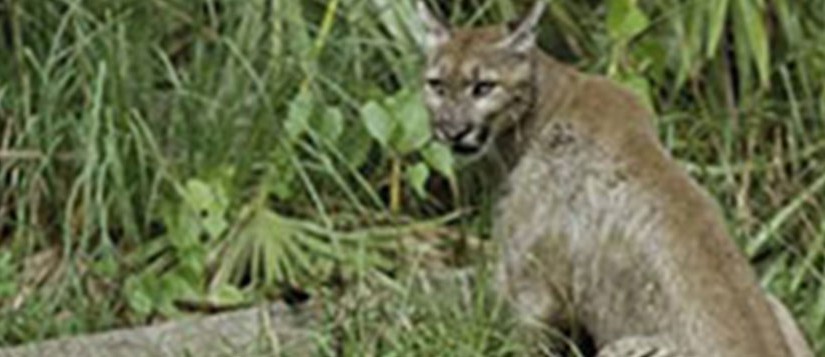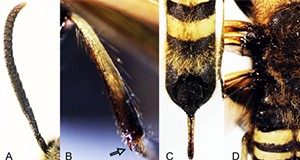
Since it was introduced to North America, the Asian woodwasp has become the most common wood wasp in Florida. It is not considered an economically important pest because it only attacks dying or dead trees, but the species may someday prove to be a pest and its ecological impacts in North American forests remain unknown. This 4-page fact sheet was written by You Li and Jiri Hulcr, and published by the UF Department of Entomology and Nematology, June 2015. (Photo credit: You Li, UF/IFAS)
http://edis.ifas.ufl.edu/in1095
Author: dihagan
Dagger Nematode Xiphinema spp. (Cobb, 1913) Inglis, 1983 (Nematoda: Enoplea: Dorylaimia: Dorylaimina: Xiphinematinae)
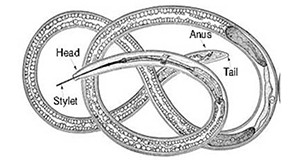
Dagger nematodes parasitize plants. They cause economic damage and death of host crops through feeding on the roots and by spreading viral mosaic and wilting diseases, but field studies have shown that some control measures targeting reduction in the population of dagger nematodes can be effective in controlling viral diseases in susceptible crops. This 7-page fact sheet was written by William K. Heve, William T. Crow, and Tesfamarian Mengistu, and published by the UF Department of Entomology and Nematology, June 2015.
http://edis.ifas.ufl.edu/in1097
Positive Discipline: Behavioral Management Skills for Parents and Teachers, Part 3: Fostering the Parent-Child and Teacher-Student Relationship to Build Responsibility
Tell me and I forget,
Teach me and I may remember,
Involve me and I learn.
The general goal of healthy parenting and teaching is to produce children and students who can think critically, make good decisions, and become independent, accountable, responsible, and contributing members of society. Part 3 of this Positive Discipline: Behavioral Management Skills for Parents and Teachers series covers tips and strategies to help parents and teachers build critical thinking and positive behavioral skills in children. Several of these strategies that can help parents and teachers achieve these goals through “love and logic” are discussed in this 6-page fact sheet written by Victor Harris, Whitney Fung, Sarah Ellis, and Alison Schmeer, and published by the UF Department of Family Youth and Community Sciences, July 2015. (Photo Credit: Thinkstock.com/iStock/natasaadzic)
http://edis.ifas.ufl.edu/fy1460
Positive Discipline: Behavioral Management Skills for Parents and Teachers, Part 2: General Approaches to Managing Behavior
When a child is locked in the bathroom
With water running
And he says he is doing nothing
But the dog is barking,
Call 911.
–Erma Bombeck
Research indicates that there must be at least an 8-to-1 positive-to-negative interaction ratio for parents and teachers to have a positive relationship with their children and students. Put simply, both verbal and non-verbal communication needs to be generally positive. Learning how to steer a child or a student toward managing his or her own behavior in healthy ways requires both knowledge and skills that make it easy to have positive interactions and behavior change. This 6-page fact sheet will help you identify specific approaches to successfully managing appropriate and inappropriate behavior at home and in the classroom. It outlines four principles of behavior management, and describes several strategies before providing a practice activity. Written by Victor Harris, Whitney Fung, Sarah Ellis, and Alison Schmeer, and published by the UF Department of Family Youth and Community Sciences, July 2015. (Photo Credit: Thinkstock.com/Jupiterimages/Creatas Images)
http://edis.ifas.ufl.edu/fy1459
Positive Discipline: Behavioral Management Skills for Parents and Teachers, Part 1: Types of Misbehaviors and Keys to Success
“Before I got married I had six theories about bringing up children; now I have six children, and no theories.” — John Wilmot
Parents and teachers often experience a lot of insecurities, especially with regard to helping children manage their own behaviors. Not surprisingly, there are many similarities in the skills that effective parents and teachers use to help children manage their own behavior successfully. Building a foundation for healthy and effective parenting and teaching begins with understanding some different types of misbehaviors. This 4-page fact sheet discusses four common types of misbehaviors, encourages the reader to identify healthy and unhealthy practices, and continues with key factors of effective parenting and teaching. Written by Victor Harris, Whitney Fung, Sarah Ellis, and Alison Schmeer, and published by the UF Department of Family Youth and Community Sciences, July 2015. (Photo credit: Thinkstock.com/iStock)
http://edis.ifas.ufl.edu/fy1458
Volunteer Training Series: 4-H Cloverbuds Program: 4-H for Younger Members
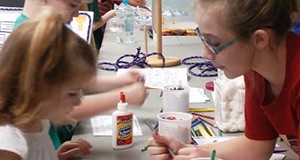 Florida 4-H programs offered to children ages 5 to 7 are called 4-H Cloverbud programs and are a component of the Florida 4-H Youth Development Program. The goal of the Florida 4-H Cloverbud program is to offer age-appropriate, fun, and exploratory learning experiences for children in the 5 to 7 age group. This 5-page fact sheet describes the best management practices 4-H faculty and volunteers should use when teaching and interacting with this age group. Written by Amanda Squitieri and Sarah Hensley, and published by the UF Department of 4-H Youth Development, July 2015.
Florida 4-H programs offered to children ages 5 to 7 are called 4-H Cloverbud programs and are a component of the Florida 4-H Youth Development Program. The goal of the Florida 4-H Cloverbud program is to offer age-appropriate, fun, and exploratory learning experiences for children in the 5 to 7 age group. This 5-page fact sheet describes the best management practices 4-H faculty and volunteers should use when teaching and interacting with this age group. Written by Amanda Squitieri and Sarah Hensley, and published by the UF Department of 4-H Youth Development, July 2015.
http://edis.ifas.ufl.edu/4h369
Lionfish: Is It Safe to Eat?
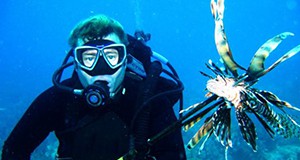
Lionfish is not a traditional or likely seafood selection, but growing interest in response to the invasive and increasing abundance has stirred recreational and commercial interest. This prolific, invasive fish is threatening reefs and coastal fisheries in ocean waters throughout the Caribbean Seas and neighboring regions, and eating lionfish is being encouraged as one of the best options to mitigate the its harmful impact. This 4-page fact sheet discusses the risks in handling and consuming lionfish, and offers recommendations for avoiding risk, for both recreational and commercial harvesters. Written by Steve Otwell, and published by Florida Sea Grant, April 2015.
http://edis.ifas.ufl.edu/sg135
Contaminants in the Urban Environment: Dioxins
 Dioxins are among the most toxic chemicals on the earth. They are by-products of a number of human activities such as combustion of fuels and wastes containing polyvinyl chloride (PVC), chlorine bleaching of paper products, and selected industrial processes. Current releases of dioxins by humans are due to the combustion of fuels and burning of household trash. The good news is that levels of dioxins in the environment have decreased in the United States throughout the past 30 years due to the improved emission controls and regulatory activities. But dioxins break down slowly, so they remain in the environment for a long time and accumulate in the food chain. Long-term exposure to dioxins can harm immune system, nervous system, endocrine system, and reproductive functions. This 7-page fact sheet discusses the sources, emission trends, and impacts of dioxins as well as the ways to minimize exposure to dioxins. Written by Yun-Ya Yang and Gurpal S. Toor, and published by the UF Department of Soil and Water Science, July 2015.
Dioxins are among the most toxic chemicals on the earth. They are by-products of a number of human activities such as combustion of fuels and wastes containing polyvinyl chloride (PVC), chlorine bleaching of paper products, and selected industrial processes. Current releases of dioxins by humans are due to the combustion of fuels and burning of household trash. The good news is that levels of dioxins in the environment have decreased in the United States throughout the past 30 years due to the improved emission controls and regulatory activities. But dioxins break down slowly, so they remain in the environment for a long time and accumulate in the food chain. Long-term exposure to dioxins can harm immune system, nervous system, endocrine system, and reproductive functions. This 7-page fact sheet discusses the sources, emission trends, and impacts of dioxins as well as the ways to minimize exposure to dioxins. Written by Yun-Ya Yang and Gurpal S. Toor, and published by the UF Department of Soil and Water Science, July 2015.
http://edis.ifas.ufl.edu/ss642
Facts about Wildlife Diseases: Rabies
 Rabies is a virus carried by mammals. It kills infected humans and animals if they are not treated shortly after exposure. Rabies can be prevented, but it cannot be cured once symptoms become evident. This 6-page fact sheet explains how rabies spreads, which animals can get it, how common it is, symptoms, what you can do to limit its spread and what to do in case of a possible rabies exposure. Written by Samantha M. Wisely and Holly K. Ober, and published by the UF Department of Wildlife Ecology and Conservation, June 2015.
Rabies is a virus carried by mammals. It kills infected humans and animals if they are not treated shortly after exposure. Rabies can be prevented, but it cannot be cured once symptoms become evident. This 6-page fact sheet explains how rabies spreads, which animals can get it, how common it is, symptoms, what you can do to limit its spread and what to do in case of a possible rabies exposure. Written by Samantha M. Wisely and Holly K. Ober, and published by the UF Department of Wildlife Ecology and Conservation, June 2015.
http://edis.ifas.ufl.edu/uw282
Climate Change: Effects on Salinity in Florida's Estuaries and Responses of Oysters, Seagrass, and Other Biota
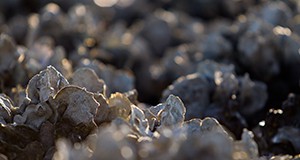 Florida’s economically important estuaries could be heavily impacted by sea-level rise and altered river flow, both caused by climate change. The resulting higher salinity, or saltiness of the water, could harm plants and animals, alter fish and bird habitat, and reduce the capacity of estuaries to provide such important services as seafood production and the protection of shorelines from erosion. This 6-page fact sheet explains the importance of estuaries, salinity in estuaries, and provides examples of stress from extreme high salinity. Then it explores the projected change in climate that could affect salinity in estuaries, how plants and animals would be affected, mitigating effects, and other impacts of climate change on estuaries. Written by Karl Havens, and published by the UF Department of Sea Grant, June 2015.
Florida’s economically important estuaries could be heavily impacted by sea-level rise and altered river flow, both caused by climate change. The resulting higher salinity, or saltiness of the water, could harm plants and animals, alter fish and bird habitat, and reduce the capacity of estuaries to provide such important services as seafood production and the protection of shorelines from erosion. This 6-page fact sheet explains the importance of estuaries, salinity in estuaries, and provides examples of stress from extreme high salinity. Then it explores the projected change in climate that could affect salinity in estuaries, how plants and animals would be affected, mitigating effects, and other impacts of climate change on estuaries. Written by Karl Havens, and published by the UF Department of Sea Grant, June 2015.
http://edis.ifas.ufl.edu/sg138
Climate Change and Ecosystem Services of Florida's Largest Water Body: Lake Okeechobee
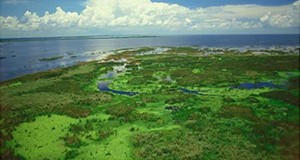 Future climate change could result in higher temperatures and greater evaporative water loss in Florida. If these changes are not compensated for by more rainfall, the state’s largest water body, Lake Okeechobee, could experience prolonged periods of very low water levels and catastrophic loss of its ecosystem services, which are the benefits that people receive from ecosystems. This 6-page fact sheet provides background, optimal and actual water levels, projected changes in South Florida climate & their effects on water levels in Lake Okeechobee, their effects on ecosystem services, and possible remedies. Written by Karl Havens, and published by the UF Department of Sea Grant, June 2015.
Future climate change could result in higher temperatures and greater evaporative water loss in Florida. If these changes are not compensated for by more rainfall, the state’s largest water body, Lake Okeechobee, could experience prolonged periods of very low water levels and catastrophic loss of its ecosystem services, which are the benefits that people receive from ecosystems. This 6-page fact sheet provides background, optimal and actual water levels, projected changes in South Florida climate & their effects on water levels in Lake Okeechobee, their effects on ecosystem services, and possible remedies. Written by Karl Havens, and published by the UF Department of Sea Grant, June 2015.
http://edis.ifas.ufl.edu/sg137
Climate Change and the Occurrence of Harmful Microorganisms in Florida's Ocean and Coastal Waters
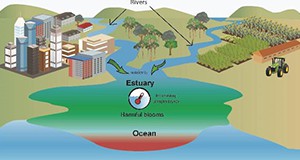 Climate change is expected to result in increased temperatures of nearshore ocean water, and this could lead to increased growth of harmful microorganisms. These include algae that form noxious or toxic blooms, including red tides, and bacteria and other pathogens. This situation could have negative consequences in regard to human health and also Florida’s ocean-related economy. This 6-page fact sheet discusses projected ocean temperatures, how harmful microorganisms living in the ocean might respond, and how this might affect people, and identifies actions that could be taken to reduce these impacts. Written by Karl Havens, and published by Florida Sea Grant, June 2015.
Climate change is expected to result in increased temperatures of nearshore ocean water, and this could lead to increased growth of harmful microorganisms. These include algae that form noxious or toxic blooms, including red tides, and bacteria and other pathogens. This situation could have negative consequences in regard to human health and also Florida’s ocean-related economy. This 6-page fact sheet discusses projected ocean temperatures, how harmful microorganisms living in the ocean might respond, and how this might affect people, and identifies actions that could be taken to reduce these impacts. Written by Karl Havens, and published by Florida Sea Grant, June 2015.
http://edis.ifas.ufl.edu/sg136
Managing Conflicts with Wildlife: Living with Coyotes
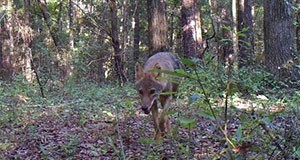 The omnivorous coyote is a relative newcomer to Florida that plays an important role in ecosystems and food webs. Of particular importance and possible benefit may be their potential ability to control populations of pest species such as some rodents. Although rare, there are situations where coyotes can become dangerous or damaging. In this 4-page fact sheet, we present some facts about coyotes, describe dangers and problems they may cause, and provide suggestions on how to cope with these issues. Written by Lauren Watine, William M. Giuliano, Holly K. Ober, Raoul Boughton, Alexander Gulde, Angeline Scotten, and published by the UF Department of Wildlife Ecology and Conservation, December 2014. (Photo: W. M. Giuliano, UF/IFAS)
The omnivorous coyote is a relative newcomer to Florida that plays an important role in ecosystems and food webs. Of particular importance and possible benefit may be their potential ability to control populations of pest species such as some rodents. Although rare, there are situations where coyotes can become dangerous or damaging. In this 4-page fact sheet, we present some facts about coyotes, describe dangers and problems they may cause, and provide suggestions on how to cope with these issues. Written by Lauren Watine, William M. Giuliano, Holly K. Ober, Raoul Boughton, Alexander Gulde, Angeline Scotten, and published by the UF Department of Wildlife Ecology and Conservation, December 2014. (Photo: W. M. Giuliano, UF/IFAS)
http://edis.ifas.ufl.edu/uw397
Third Grade Manatee Curriculum
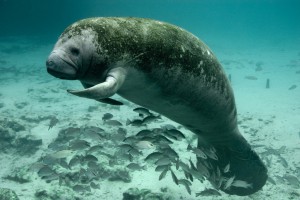
This 19 fact sheet curriculum series provides a series of individual lessons covering manatee biology and ecology, as well as highlighting some of the ways that humans impact and can protect manatees. The curriculum has been written at a third grade level but can be adapted for older or younger students. (Photo credit: Keith Ramos, USFWS)
http://edis.ifas.ufl.edu/topic_series_third_grade_manatee_workbook
Summary of 2013/14 Production Costs for Indian River Fresh Market Grapefruit and Southwest Florida Juice Oranges
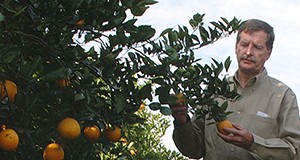
This 10-page report, developed through interviews with growers who managed their own citrus groves, outlines the cost of production budgets for fresh grapefruit and juice oranges grown during the 2013/14 season. The Florida citrus industry is on a steep learning curve as it collectively tries to maintain economically sustainable fruit yields from HLB-infected trees. Growers are experimenting with new materials and management strategies to reduce psyllid populations and improve a tree’s overall nutritional health. As a result, production costs have increased threefold since 2004. Between the 2012/13 and the 2013/14 seasons, production costs increased 30% and 34% for fresh grapefruit and juice oranges, respectively. Since 2004, production costs for fresh grapefruit have increased 182%, while costs to grow juice oranges have increased 211%.
Written by Fritz Roka, Ariel Singerman, and Ronald Muraro, and published by the UF Department of Food and Resource Economics, July 2015.
http://edis.ifas.ufl.edu/fe968
Doveweed (Murdannia nudiflora) Control in Warm-Season Turfgrass Species
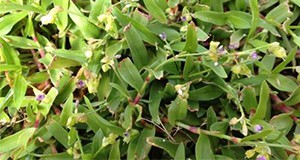 Doveweed is an aggressive, naturalized summer annual weed that rapidly invades warm-season turfgrass species, especially in residential lawns, and few herbicides can effectively control it. Because of these challenges, a well-designed management strategy is necessary for doveweed control. This 4-page fact sheet describes identification, growth requirements, chemical control and cultural practices. Written by Ramon G. Leon and Bryan Unruh, and published by the UF Department of Agronomy, June 2015.
Doveweed is an aggressive, naturalized summer annual weed that rapidly invades warm-season turfgrass species, especially in residential lawns, and few herbicides can effectively control it. Because of these challenges, a well-designed management strategy is necessary for doveweed control. This 4-page fact sheet describes identification, growth requirements, chemical control and cultural practices. Written by Ramon G. Leon and Bryan Unruh, and published by the UF Department of Agronomy, June 2015.
http://edis.ifas.ufl.edu/ag395
Commercial Production of Ornamental Tropical Foliage Plants: Micropropagation
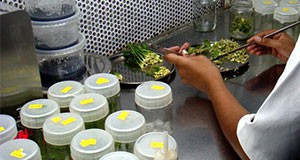 Florida nursery operators need to understand plant propagation principles and techniques so they can grow enough plants for sale. Micropropagation is a way to culture plant tissue to rapidly propagate a large number of plants. This 4-page fact sheet presents an overview of micropropagation to help growers evaluate it as a propagation technique for their own nursery operations. Written by J. Chen and R. J. Henny, and published by the UF Department of Environmental Horticulture, May 2015. (Photo: J. Chen, UF/IFAS)
Florida nursery operators need to understand plant propagation principles and techniques so they can grow enough plants for sale. Micropropagation is a way to culture plant tissue to rapidly propagate a large number of plants. This 4-page fact sheet presents an overview of micropropagation to help growers evaluate it as a propagation technique for their own nursery operations. Written by J. Chen and R. J. Henny, and published by the UF Department of Environmental Horticulture, May 2015. (Photo: J. Chen, UF/IFAS)
http://edis.ifas.ufl.edu/ep520
Do a Visual Presentation
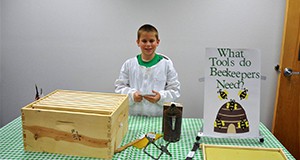 A visual presentation, either a demonstration or an illustrated talk, is a teaching method in which the presenter shares information with an audience with the assistance of visual aids such as posters, models, and computer presentation software. This 4-page fact sheet covers the method of delivery, the plan, the visuals, how to look sharp and to have a sharp presentation. Written by Stacey Ellison, and published by the UF Department of 4-H Youth Development, June 2015.
A visual presentation, either a demonstration or an illustrated talk, is a teaching method in which the presenter shares information with an audience with the assistance of visual aids such as posters, models, and computer presentation software. This 4-page fact sheet covers the method of delivery, the plan, the visuals, how to look sharp and to have a sharp presentation. Written by Stacey Ellison, and published by the UF Department of 4-H Youth Development, June 2015.
http://edis.ifas.ufl.edu/4h163
Florida Carpenter Ants
 Carpenter ants are in the genus Camponotus, in which up to over 900 species have been described worldwide. They get their common name, “carpenter ant,” because some species excavate nests in wood. Carpenter ants are sometimes called bulldog ants or bull ants. However, not all species in the genus Camponotus are true carpenter ants because some nest in preformed cavities or in soil. This 5-page fact sheet was original published as part of Pests in and around the Florida Home, and was written by R. J. Vazquez, P. G. Koehler, R. M. Pereira, J. Warner, and R. H. Scheffrahn, and published by the UF Department of Entomology and Nematology, October 2013.
Carpenter ants are in the genus Camponotus, in which up to over 900 species have been described worldwide. They get their common name, “carpenter ant,” because some species excavate nests in wood. Carpenter ants are sometimes called bulldog ants or bull ants. However, not all species in the genus Camponotus are true carpenter ants because some nest in preformed cavities or in soil. This 5-page fact sheet was original published as part of Pests in and around the Florida Home, and was written by R. J. Vazquez, P. G. Koehler, R. M. Pereira, J. Warner, and R. H. Scheffrahn, and published by the UF Department of Entomology and Nematology, October 2013.
http://edis.ifas.ufl.edu/in1075
Managing Conflicts with Wildlife: Living with Panthers
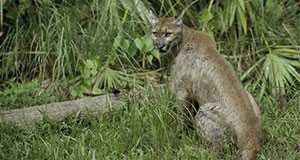 Panthers help maintain populations of some native species and control nuisance species such as wild hogs. They are generally secretive and rarely bother people, but there are rare situations where panthers can become dangerous or damaging. In this 4-page fact sheet, we present some facts about panthers, describe dangers and problems they may cause, and provide suggestions on how to cope with these issues. Written by William M. Giuliano, Holly K. Ober, Lauren Watine, Raoul Boughton, Eric Hellgren, Darrell Land, and Mark Lotz, and published by the UF Department of Wildlife Ecology and Conservation, December 2014.
Panthers help maintain populations of some native species and control nuisance species such as wild hogs. They are generally secretive and rarely bother people, but there are rare situations where panthers can become dangerous or damaging. In this 4-page fact sheet, we present some facts about panthers, describe dangers and problems they may cause, and provide suggestions on how to cope with these issues. Written by William M. Giuliano, Holly K. Ober, Lauren Watine, Raoul Boughton, Eric Hellgren, Darrell Land, and Mark Lotz, and published by the UF Department of Wildlife Ecology and Conservation, December 2014.
http://edis.ifas.ufl.edu/uw399



